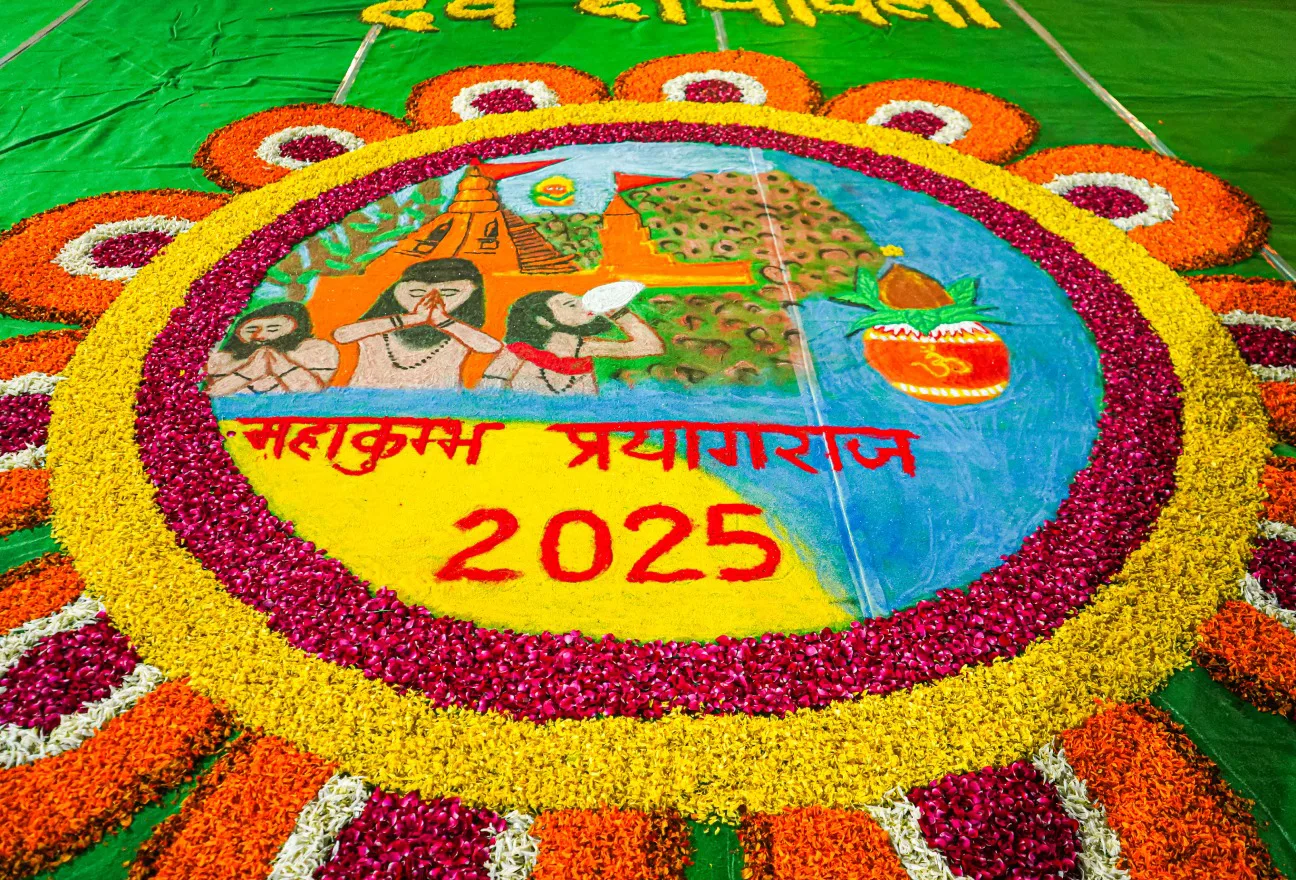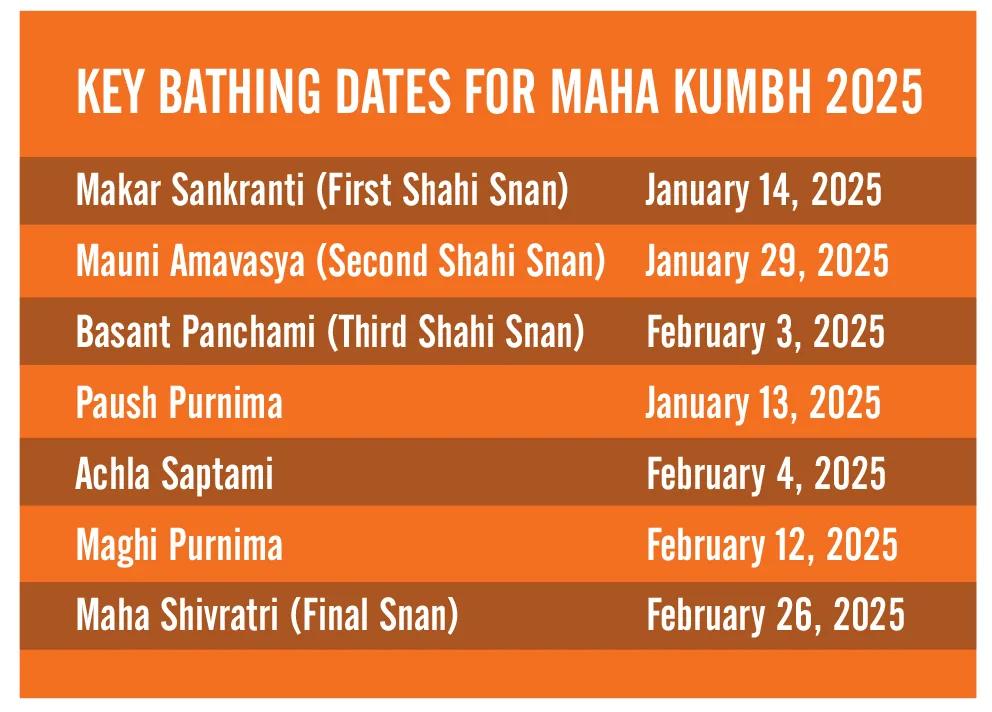During the Kumbh Mela in Haridwar in 2010, a young Frenchman exclaimed, “Oh, it must have been so different then” when he came to know that I was in 1986 at the Kumbh already. “No, it was not”, I realised. It was very much the same. It may have been the same for centuries.
Here is my description of the Kumbh Mela in 1986: Luckily I didn’t get afraid when I am stuck in a crowd. I actually enjoyed the atmosphere, so incredibly colourful and diverse, a wave of human beings that carried everyone along, innumerable pairs of eyes meeting my eyes, fleetingly, friendly – for a short while thrown together at the same place.
Purification of Soul
So when I heard that Kumbh Mela will be celebrated in Haridwar in April 1986, I wanted to be there. For surely there must be a reason, when millions of pilgrims from all corners of Bharat undergo a lot of hardship to reach this festival on the Ganges. In fact, there are two reasons.
Number one, a bath in the Ganges at the auspicious time of the Mela is a big attraction, because it is supposed to be very powerful, purifying internally and giving a boost to one’s spiritual development. And number two, there is the prospect of benefitting from the presence of great Rishis, the successors of the ancient women and men from Vedic times.

Traditionally, the Kumbh Mela is the meeting place for those pillars of Bharatiya spirituality, who have dedicated their whole life to the search for truth. Even today the hermits, who are usually hidden in caves in the Himalayas, and the sadhus (wandering monks), who wander all over the country with a begging bowl and a staff in hand, embody the dream of freedom and independence for those who feel tied down in the world.
The reason why during the time of the mela, bathing in the Ganges is especially helpful for spiritual growth is given in a story, which is since ancient times connected with existing locations in Northern Bharat.
Long, ago, at the beginning of our present world cycle, Gods and demons tried to release the lost nectar of immortality by vigorously churning the milk ocean. When the jar (Kumbh) full to the brim with the nectar finally emerged, a wild chase started. The son of a God seized the vessel with the precious content and the demons followed in hot pursuit. Sun, Moon and Jupiter played the role of protectors for the Gods and influenced the outcome in their favour from certain positions…
The chase lasted for 12 days, until the jar was finally safe with the Gods.
Relevance of Four Sacred Cities
According to the historians, a few drops of the nectar spilled over at four places in Northern Bharat, which thereby became sanctified. This led to celebration of the Kumbh Mela once in 12 years – Haridwar, Allahabad, Nasik and Ujjain.
When the drops fell into the Ganges in Haridwar during the chase, the Sun protected it from the position of Aries and the Jupiter from Aquarius. This constellation repeats itself once in 12 years, because one year in the lives of human beings corresponds to one day in the lives of Gods. Each time, when this constellation repeats itself, the influence of the celestial bodies is again supposed to be very beneficial for the place and millions of pilgrims converge at the place to celebrate the Kumbh Mela.
It explains why many pious Hindus dream of bathing in the holy river during the Kumbh Mela. The explanation, however, may not convince a European. When I walked along the banks of the Ganges, and watched the pilgrims, who stood up to their waist in the water, bent their knees and submerged themselves again and again, I would not have guessed that this kind of exercise is helpful in getting to know the truth.
No Compulsion For Holy Dip
But can I be sure? It can neither be verified nor falsified, whether the astrological constellation in question changes the Ganges water in some subtle, special way or not. And after seven years in Bharat, I was already broad minded enough to consider the Bharatiya view as possible and not the Western view, which would regard such belief ‘from a scientific angle’ as nonsense. The Bharatiyas trust that their sages and their tradition. They know a lot about the subtle interdependence between men and cosmos. And they may be right. Science keeps validating more and more insights of ancient wisdom.
To be fair, Westerners should have the same level of acceptance towards the Bharatiya belief, which they have towards the baptism in the Christian Church. Rather even a higher level, as no Bharatiya threatens anyone with eternal damnation, if he does not bathe in the Ganges.
Rani Ma Acts as Guide
I personally did not consider the bath as important. Nevertheless, it so happened that in the middle of the night at 2 am, at the most auspicious hour, I went to the Ganges to take a dip. A group of people who were gathered around a tiny, fragile woman, Rani Ma by name, took charge of me. I had landed up in this group the previous evening by chance.
Rani Ma did not talk much. Her Guru was Babaji, who was also the grand guru of Paramahansa Yogananda. Her devotees from Kolkata considered her as enlightened.
There was no doubt that this group would take a bath in the Ganga in the night and Rani Ma insisted on taking me along. I did not object. We slept for a couple of hours on reed mats on her veranda and then joined the steady, unending stream of human beings winding their way through the town to Har ki Pauri, the most auspicious place on the Ganges. The stream was so dense that I hardly managed to bend to take off my slippers when we reached the ghat area. The others had wisely left theirs behind. There was real danger that the stream of people would run over one, if one fell to the ground.
Things took an ugly turn when 50 people had died in the night. The continuous stream of pilgrims had been blocked for a while to make way for some VIP politician and then was waved on. Many, who had squatted on the ground and dozed off while waiting, could not get up fast enough, when the crowd suddenly moved forward. They were trampled to death.
Even then there was amazing experience when half a million sadhus, swamis, sanyasis, as the potentially holy men and women, had come to Haridwar – a good representation of spiritual Bharat. Anandamayi Ma had already passed away, but Devaraha Baba was there and I was happy to have his darshan again.
The Mela presented a colourful, fascinating picture. Many sadhus were smeared with ash from head to toe. Others had wrapped an orange coloured, sometimes also white or black, and often worn out cotton cloth around their hips. On their foreheads they had mysterious marks. In one hand, they usually held a begging bowl and in the other, a wooden staff and in some cases, a dangerous looking metal trident. Their hairstyle was unusual. If their heads were not shaven, their hair was matted with ash and piled in several layers on the head or it reached down to the waist.
To be fair, Westerners should have the same level of acceptance towards the Bharatiya belief, which they have towards the baptism in the Christian Church
If I had not noticed it earlier, I would have noticed it during the Kumbh Mela – the fact that not all of them were close to santattva. Only because someone is naked or dressed in orange, does not necessarily mean that he is a pure, calm, great being who is a well-wisher for all of mankind.
There were also the genuine ones who had dedicated their lives to the search for the truth – fully and sincerely – and among them there might have been some who had come to an end of their search and could feel what they truly are in their essence.
I have to admit that I did not meet too many really impressive personalities, but there were some who lived their lives from a deeper, more awakened level of consciousness. Once for example I was sitting on a small wooden bench in front of a tea shop on the road side. An elderly man with a towel wrapped around his head sat down next to me. I moved a bit away from him, because his clothes looked dirty.
A skinny bitch, whose puppies were stepping over each other under her belly, positioned herself behind our bench and looked at us full of expectation. We both turned towards her at the same moment, and I was surprised, how much compassion shone from the eyes of this man.
Now I suddenly felt love for him and wondered whether it was appropriate to pay for his tea, as he looked poor. Just then Melita Maschmann passed by and we chatted. Meanwhile the man paid and left. We also left and Melita pointed at him, “Look at this man in front of us. People here claim that he is enlightened. He is always calm, kind, unperturbed, even though he is poor and earns his livelihood by collecting mud for soaps.”
Melita and I participated in the morning arati in the temple where Anandamayi Ma’s samadhi (memorial) is the focus of worship. Afterwards we went off in different directions. I was walking, when the man from the teashop came to my mind, and I wished I would see him once more. Somebody walked ahead of me, but he didn’t have a towel around his head, so I didn’t take further notice. Suddenly I became aware of the prominent varicose veins on his legs and realised that it was him. At the same moment, he turned and smiled at me.

Some other time, I sat with a group of people on Rani Ma’s veranda, when a sadhu from Uttarkashi in the Himalayas joined us. Rani Ma greeted him warmly. Both of them conversed with each other for a while. Then he sank into stillness. We all were still and it felt very peaceful. After he had left, Rani Ma claimed that he was enlightened. Of course I can’t know whether it was true. Probably I have walked past a number of people without recognising that he or she were enlightened souls. I suppose that there were some even in those huge tents. There people chanted almost non-stop one of the many names of God. Among them there were emaciated old men with hollow cheeks and sunken eyes, who accompanied their chanting with cymbals – and had time to look up and invite me with a smile to join in.
They were devotees of Vishnu, who is the preserver of the universe. Vishnu is said to incarnate in human form on earth, whenever evil gets the upper hand, to show again the right path to human beings. Ram and Krishna are Vishnu’s most loved incarnations (avatars). The life story of Ram is narrated in the Ramayan and Krishna’s in the Mahabharat. The devotees of Vishnu are generally milder compared to those of Shiva. They want to be constantly and lovingly aware of His presence and merge with him or rather merge with that form of Him, which they love the most.
When I got up to leave, an old man advised me to travel to Ayodhya and even asked whether I had enough money for the train ticket to get there. He genuinely wanted me to visit the birthplace of his beloved Ram, who is for a Hindu the same as Jesus Christ is for a Christian – God in human form.
In front of a photo shop, a young sadhu approached me and asked in fluent English where I came from. He was wearing only a loin cloth and was a Naga sadhu, since yesterday. The previous day I had witnessed, as a few thousand young men who sat on the banks of the Ganges, their heads freshly shaven and naked except for a loin cloth. They “took sanyas”, that means, they vowed to renounce the pleasures of the world and not to dream anymore of wealth, family and position. One of those young men stood now before me, who, only the day before yesterday, would have looked completely normal, with shirt and trousers on his body and hair on his head. I asked him why he chose to become a Naga sadhu. “I want to meditate in a cave in the Himalayas to become one with God”, he answered, as if this kind of desire was the most natural thing in the world for a young man of his age. I used the opportunity to ask him whether he could introduce me to his guru. He readily agreed.
Shiva’s Warriors Challenge Mughals
The Naga sadhus consider themselves as the warriors of Shiva. Shiva is on one hand the destroyer in the trinity besides Brahma, the creator and Vishnu, the preserver. On the other hand, Shiva is considered to be the highest, the only one, above the trinity.
In the 8th century, some say, even earlier, that the great philosopher Adi Shankara had grouped the individual sadhus into ten orders, as per their main spiritual practice, reacting to the Buddhist monk communities. Adi Shankara also asked them to visit the Kumbh Melas, to keep in touch with each other and to exhort the common people to live a righteous life.
The Naga sadhus fought against the Islamic invaders, who between 8th and 18th century made lives difficult for Hindus and often killed them if they did not convert to Islam
The Naga sadhus fought against the Islamic invaders, who between 8th and 18th century made lives difficult for Hindus and often killed them if they did not convert to Islam. I also dared to take a photo of the Nagas, even though the press officer had asked us not to. Secretly and quickly with my small Minox , I made sure that the film was developed. Three Nagas looked directly into the lens.
Mustering Courage for the Journey
Many sadhus muster courage to untie all their relationships and let go of the dream of a happy family life and success in a career – in favour of an inward journey, where they have to walk alone, without health insurance and without being certain that the next meal will indeed find its way into their begging bowl? ‘If in doubt, be in favour of the wandering monk’ is still the motto in Bharat. And even critics of the spiritual scene in the country do not doubt that there are enlightened beings among the sadhus, somewhere high up in the inaccessible Himalayas – who only leave their cave for the Kumbh Mela…



















Comments